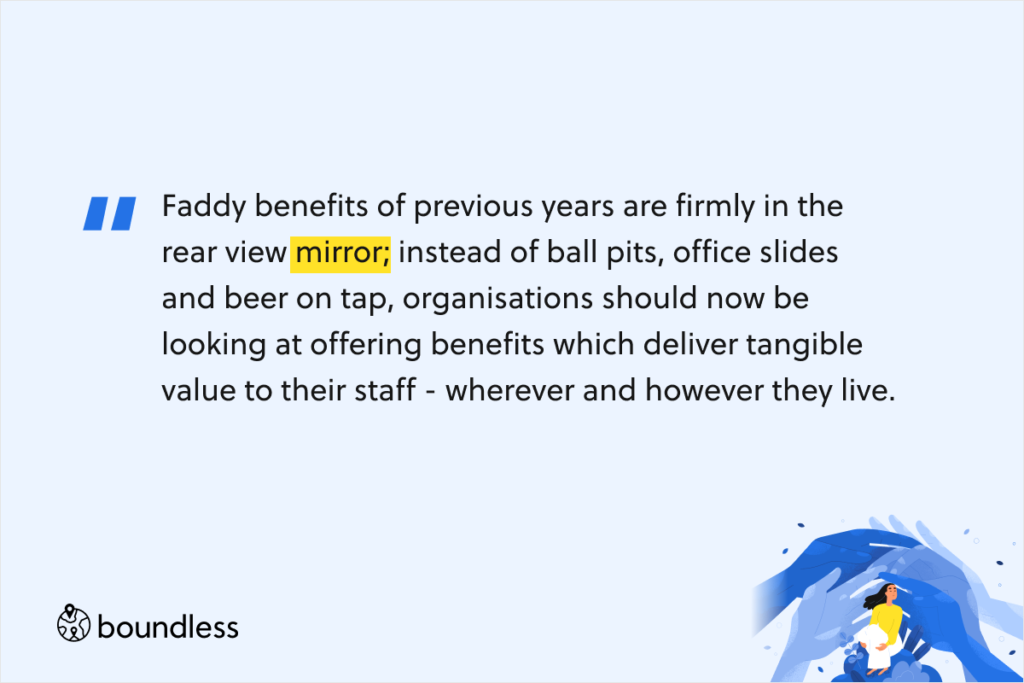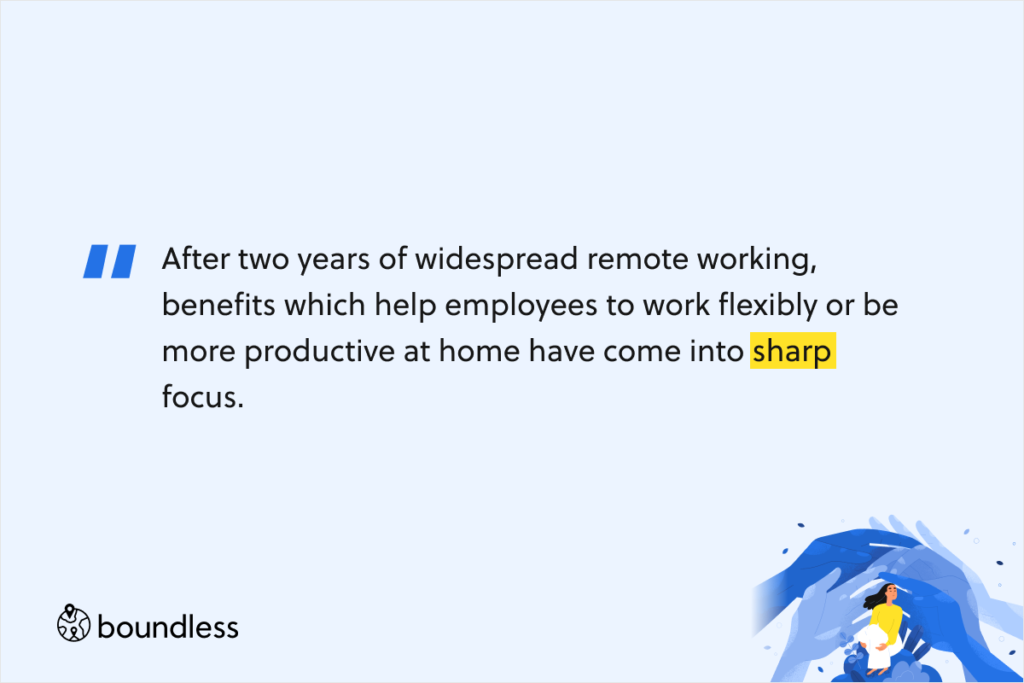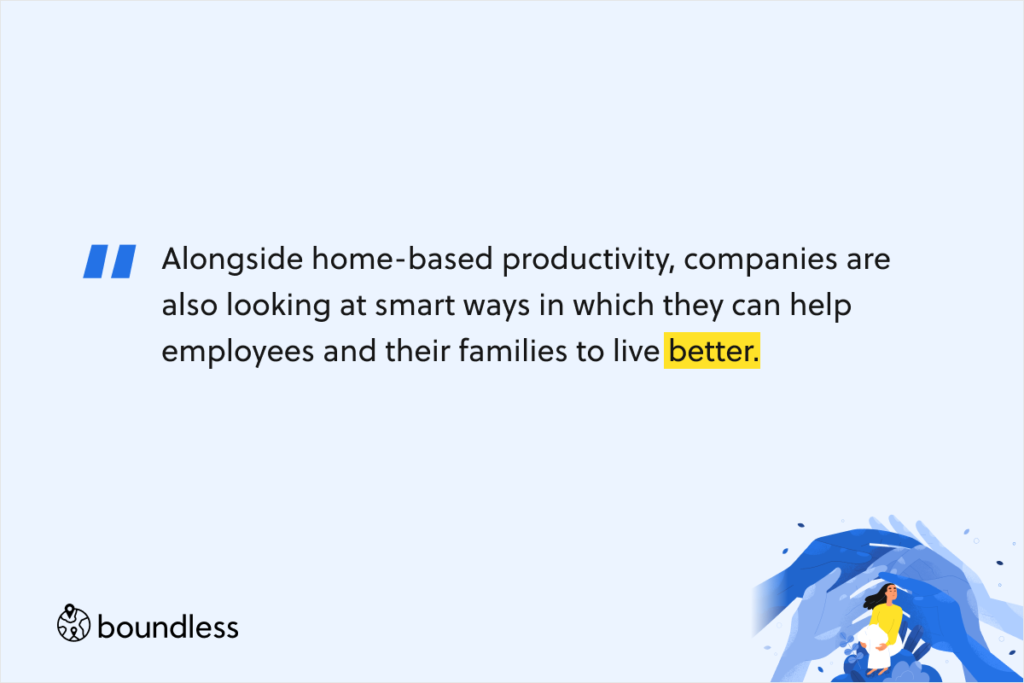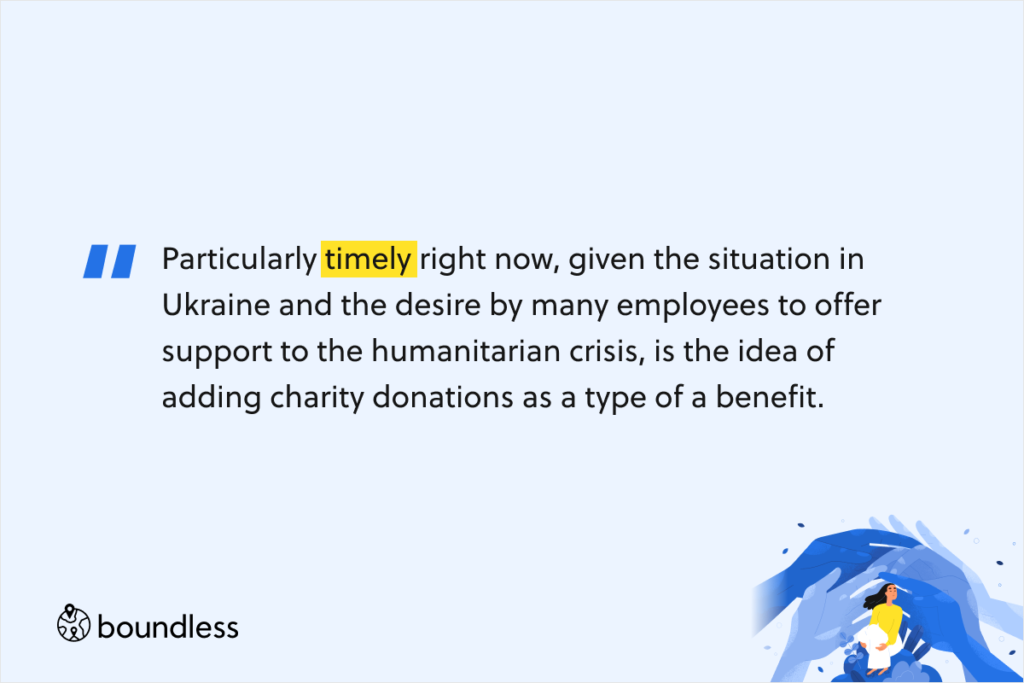A benefit in kind is any non-cash benefit of monetary value that an employer provides to employees. Unlike statutory benefits, which are mandated by the government, benefits in kind are something that a company offers at its own will.

Against the backdrop of an ultra-competitive jobs market, it’s no surprise employers are looking toward what constitutes a progressive employee benefits package as a way to attract and retain staff. And with the pandemic prompting millions of employees to reconsider where they work and what they do, employers are having to think particularly hard about which benefits really matter most to their team members.
Faddy benefits of previous years are firmly in the rearview mirror; instead of ball pits, office slides and beer on tap, organisations should now be looking at offering benefits which deliver tangible value to their staff - wherever and however they live.
So, what should a competitive employee benefits package include?
Well, outside of pension and health insurance plans, benefits span a wide range of categories - including health and wellbeing, training and learning, lifestyle and entertainment, and more. Here are some of the leading contenders for your organisation to consider.

Post-pandemic, employers are now much more aware of employee wellbeing, understanding that teams who are well and happy are more likely to be productive, settled and loyal. Medical insurance, private healthcare dental cover and optical/vision packages are popular benefits in this category today – thanks to the direct impact they have on wellbeing. Employees get quick access to great services and support, and employers ensure their staff are treated faster and are able to get back to work sooner.
And it’s not just doctors, dentists and optician’s appointments which are highly coveted. Benefits in this category can be pretty broad – including everything from fitness classes and gym membership to counselling, psychotherapy and meditation app subscriptions. Access to general health checks are becoming more popular too - as well as beauty treatments and even help with nutrition such as vitamin subscriptions and meal boxes.
If you’re looking at providing health and wellbeing benefits, you might also consider products and services specifically to women, such as subscriptions to period products or healthcare services. Indeed, some companies like Apple and Facebook have long provided fertility treatments such as egg freezing, while, elsewhere, Snapchat, Salesforce and Spotify are offering to fund surrogacy for their employees. While not a monetary-value benefit, there is also a growing appetite for paid menstrual leave.
Closely related to wellbeing is ‘training and learning’ – benefits that allow employees to garner skills either related to their job or their outside interests. News subscriptions, conference tickets and online courses are all very popular within this field, and some forward-looking companies are also providing access to business or life coaching services, as a way of demonstrating their commitment to people’s overall development.
Tech giant Adobe is a great example to take inspiration from – the company offers employees $10,000 per year for tuition and books for courses and graduate programmes. Additionally, Adobe allows employees to set aside pre-tax savings for their children's college education, making life a little easier in the long-term and encouraging staff loyalty in the process. Even if you can’t match this level of education contribution, putting any amount towards the further training of your employees will be highly beneficial and appreciated. The good news is that, for the most part, benefits that fall under Training and learning and are not subject to benefit in kind tax.

After two years of widespread remote working, benefits which help employees to work flexibly or be more productive at home have come into sharp focus. Some companies, such as Shopify, have provided employees with grants to spend on furnishing a home office, while others have directly provided equipment themselves – not just desktops and laptops but also ergonomic chairs and desks and even storage. Access to co-working premises is also increasingly popular – the premise of hiring out permanent office space in a flexible shared office - so that staff can set up and work from multiple locations, depending on where they are and what they need.
Some organisations are going even further, offering employees the chance to employ PAs or other support services who can help them to organise their professional life, as well as financial advisors to assist with money management.
Alongside home-based productivity, companies are also looking at smart ways in which they can help employees and their families to live better. Under this category, you can find diverse perks ranging from flower, coffee and snack subscriptions, to members’ club access or restaurant vouchers.
Some employers are also finding that their team members need help to keep their home life organised, and hence they’re using their benefits offering to provide access to laundry and dry cleaning services, cleaners or meal subscription packages.
Finally, firms looking to provide a full and comprehensive benefits package to staff will want to consider how employees spend their free time too - and look at entertainment services such as cinema vouchers, streaming services, leisure devices and even vacation travel money!

If employees are still required to travel - either commuting to the office or travelling to other locations - many companies are catering to this need by offering public transport travelcards, taxi and car services and even car loans. Of course, the working world is fast changing and the shift to remote working has removed the need for this category for some companies – however for others, it remains vital – and you may find your employees still really value help with travel and transport.
Some benefits in the travel and transport category are supported by a subsidiary or tax breaks - including cycle to work schemes in places such as the UK and Ireland, which were introduced more than a decade ago. It’s important to remember there may be help available for companies which do want to go down this route.
Employees want to know that, if there’s an unforeseen calamity in their lives, then they’re covered. Aside from health insurance, which we’ve covered already, there are plenty of other insurance type benefits which are popular with employees around the world. Life, pet or home insurance policies help employees to feel that their home and family life is protected, travel insurance means that staff can traverse the globe with confidence, and gadget insurance helps to protect those all-important devices that we rely on for both work and pleasure.

Particularly timely right now, given the situation in Ukraine and the desire by many employees to offer support to the humanitarian crisis, is the idea of adding charity donations as a type of benefit. This could be done by, either the employer making donations in full on behalf of employees or offering the option for employees to use some of their benefits budgets for donations and then matching them. Goodbox tells us that some of the most popular charities being supported in the UK right now range from the Red Cross to the RSPCA, as well as local community groups, food banks and more. Charitable giving doesn’t always have to involve money - for example, some companies give paid leave to employees who want to donate their time to good causes – what is crucial is that companies are cognisant of how employees feel about their obligations to the wider world and provide support accordingly.
It’s unlikely that you’ll be able to offer all of these benefits as standard. That is okay because not all of them will be relevant to all of your workforce. But there’s an answer to be had – in the form of a flexible, self-managed employee benefits package where employees can pick the categories of benefits that make sense for them and nail down specific options from a list of pre-vetted suppliers. It's a win-win situation: your employees get what they most want – and you are able to show that you're putting your team members’ needs first.
Crucially, the move to more flexible packages will help you to manage benefits across multiple territories – currently, a major pain point for global businesses, as companies need not only to respect a nation’s statutory benefits but also country-specific taxation on benefits in kind and their cultural norms.

There’s plenty to consider when it comes to an employee benefits package but it’s worth your while to get it right in order to attract and retain the best talent. According to new survey data released by Randstad US, 60% of respondents find the benefits package the largest determining factor when considering job offers.
Need a hand getting started with offering benefits? We’re working on a new benefits platform that makes managing employee benefits across borders easy and pain-free. Stay in the know for when we go live.

A benefit in kind is any non-cash benefit of monetary value that an employer provides to employees. Unlike statutory benefits, which are mandated by the government, benefits in kind are something that a company offers at its own will.

Your employee benefits tell a story about what kind of business you are and how you value your people. If you get your benefits package wrong, you could miss out on the best hires or lose existing team members to the competition.

Savvy businesses know that to attract and keep hold of employees they need to set themselves apart from the competition – easier said than done in today’s increasingly remote-first working world, where people can work for pretty much anyone, anywhere.

The best employers know that focusing on salary alone will only get you so far. You also need to create loyalty amongst your people. This is why employee benefits matter. They provide the support that impacts all aspects of people’s lives – our health, our happiness, our family, and even our future.

Building a UK employee benefits package from scratch can feel quite daunting. After statutory benefits are sorted, you have to decide which additional benefits to offer. You will have to determine which benefits have the highest ROI while enhancing the employee experience and company culture.

All evidence suggests that the remote work revolution is here to stay. The vast majority of employees now expect the chance to work remotely to some capacity and if they don’t get what they want, they’re prepared to turn in their resignation and move to a more accommodating employer.